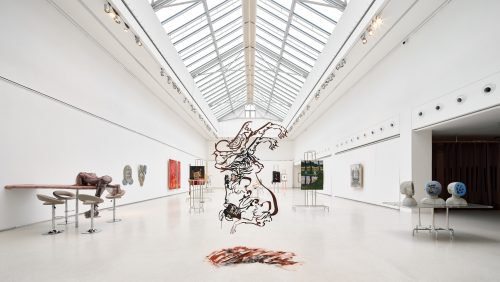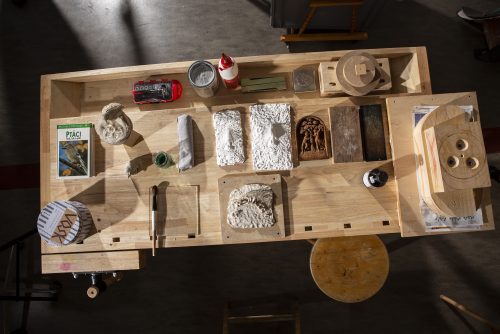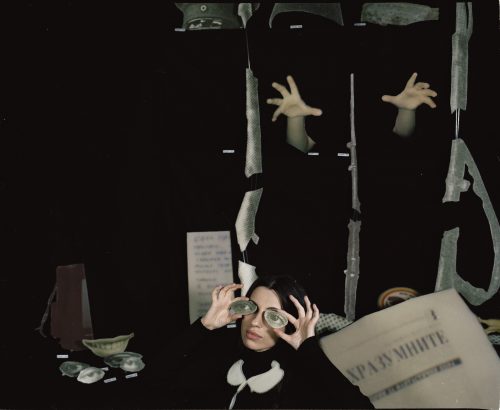
Groupshow
Trust Issues
Project Info
- 💙 Kornfeld Gallery
- 💚 Nina Chkareuli-Mdivani
- 🖤 Groupshow
- 💜 Nina Chkareuli-Mdivani
- 💛 Andrea Katheder
Share on

Advertisement






"A secret sadness lurks behind the twenty-first-century’s forced smile." – Mark Fisher, author of “Capitalist Realism”.
The time we live in marks our trust in physical freedom and in the freedom of thought essential; the proliferation of fake news has turned trust into a precious commodity. Can we completely believe algorithms, templates, chat GPT interactions, prejudices, and preconceptions? How could we stop being vulnerable to preprogrammed biases and refrain from happily consuming them? London-based multidisciplinary artist Saelia Aparicio, Mexico-based painter Gonzalo Garcia, and Tbilisi-based painter Rusudan Khizanishvili take up issues of vulnerability, trust, and power while foregrounding their distinct visual modes of expression. Aparicio’s anthropomorphic wood sculptures, Garcia’s oil paintings on linen that are gentle and brutal at the same time, and Khizanishvili’s strong and symbolic colors engage in a visual discourse. The three transgressive artists want to wake us up through strong visual statements that are sometimes intentionally ambiguous or ironic, sometimes grounded in specific political events such as the anti-government protests in Georgia in 2024-2025 or Mexico’s student protests in the 1960s.
In her new oil paintings, Rusudan Khizanishvili uses a play on words and symbols. Painted during the first political protests in Georgia in the spring of 2024, the artist thought about protective and political covers as a means of controlling societies. Theatrical red covers are part of behind-the-scene mechanisms that Khizanishvili portrays throughout her artistic career. Some of these mechanisms could be traced to the Persian miniatures, while others to the mythological representation of guardians. Khizanishvili’s figures are abstracted from individual characteristics when it comes to presenting human or social dramas; they could be pagan or neohuman with indirect references to Michel Houllebecq' novels, but at the center is our souls and their pursuit of harmony.
Gonzalo Garcia’s representational oil paintings approach trust, power, and violence in a more literal and deliberately transgressive, confrontational way meant to arouse our sense of unreality and disbelief. Scenes of castration and potential physical or psychological torture are dynamically unfolding in front of our eyes. Inspired by Mexican cinema of the 1970s and films such as El Castillo de la Pureza by Arturo Ripstein and Los Cachorros by Jorge Fons, Garcia is interested in creating a hybrid history of authoritarian utopia insisting on gender corrections. We do not see the faces of either torturers or their victims, but we are free to add identities and details ourselves. Lyrical still lives centered on the artist’s earlier investigations of their queer identity abstractly set in marketplaces and their childhood dwellings in Mexico City, are painting much gentler images of transformation, surrender, and freedom to exist.
Saelia Aparicio takes an experimental approach to investigate where we, as physical bodies, are at in this time of capitalist realism as defined by philosopher Mark Fisher, to whom the artist feels a close affinity. Her anthropomorphic stools and drawings work with human, genderfluid bodies that are deliberately vulnerable and playful. The resulting sculptures and drawings are cross-referenced by folklore, popular culture, and feminism, but also by the sheer materiality of wood, glass, fabric, and clay. The questions Aparicio asks are how can we remain human and open with all the oppressive forces working against us. Her answer is of hope, risk, humor, and experimentation, between the rigid classifications, between dualities, there are fissures where we can find space for the unknown, for mutant creatures that open a window to the unexpected, not limiting ourselves to what is prescribed either by digital structures or by doom porn.
All three artists use different formalistic devices to investigate degrees of trust and how we, as a human species, can survive this time of uncertainty. It seems only humor, harmony, risk and art can help us to solve our trust issues.
Nina Chkareuli-Mdivani




